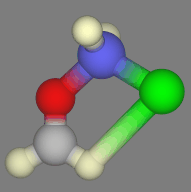The Silicon Graphics Teaching Laboratory
has been replaced by the
Chemical Information Laboratory
and this information is for historical interest only
Normal Modes
A minimum energy conformation of a molecule will not be still, even at
absolute zero of temperature, but will wobble around. These movements
can be separated into a series of simple motions, called the normal
modes, each of which corresponds to a particular frequency. Analysis of
the normal modes allows us to see which motions have low energy, and
which are less accessible.
Some examples are in the directory /usr/local/examples/NMA of the
Silicon Graphics Teaching Laboratory.
To see
them, use the program Eadfrith.
Make sure that NMA (option G) is switched on. When the molecule
appears, you can see its normal vibrational modes by moving the mouse
around with no buttons pressed. Pressing the mouse buttons manipulates
the molecules in the normal way.
Normal mode analyses are given for water, methane, and a formaldehyde
H2BCl complex. They were all calculated using ab initio molecular orbital
theory.
The lowest normal mode of the complex of H2BF with formaldehyde

|